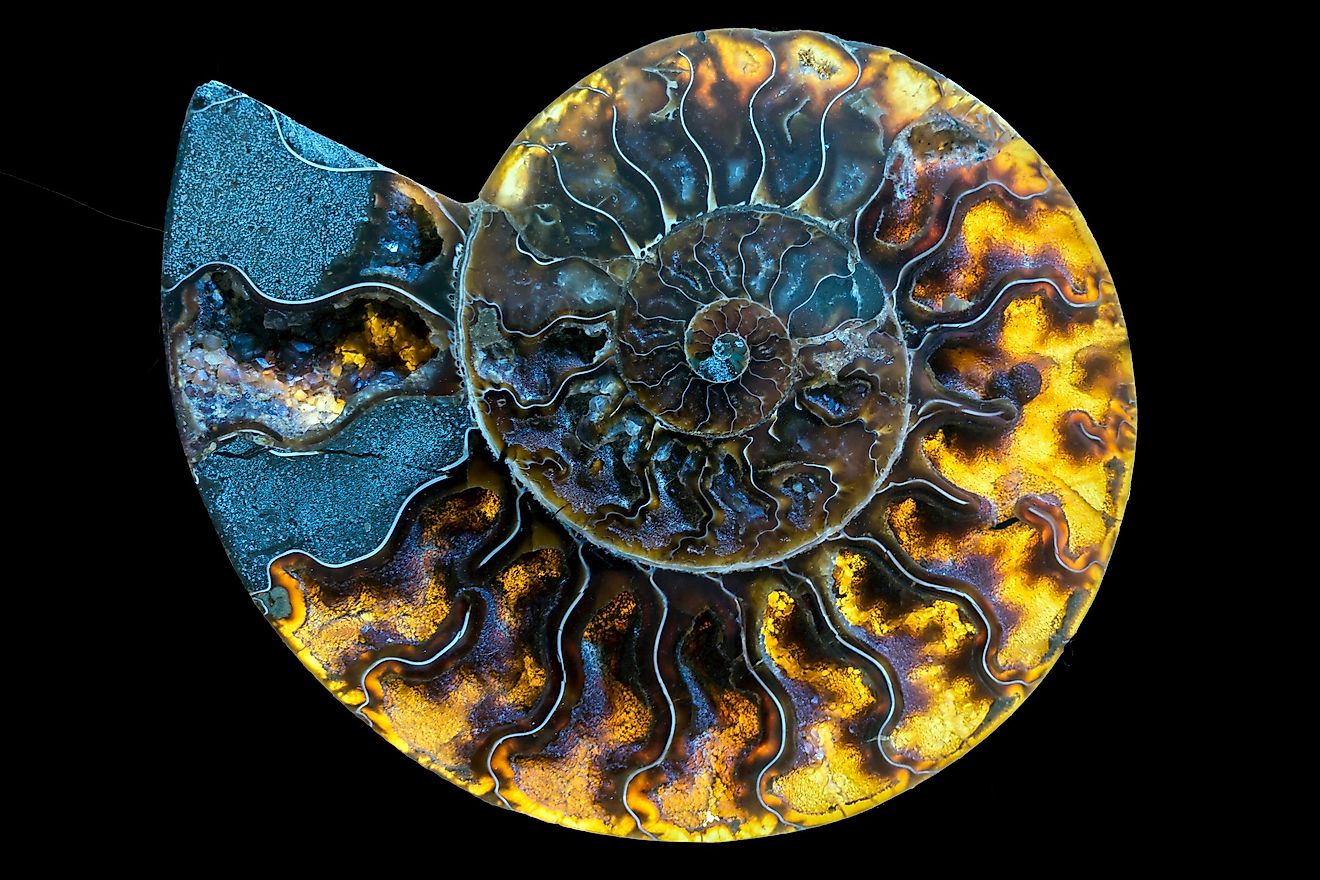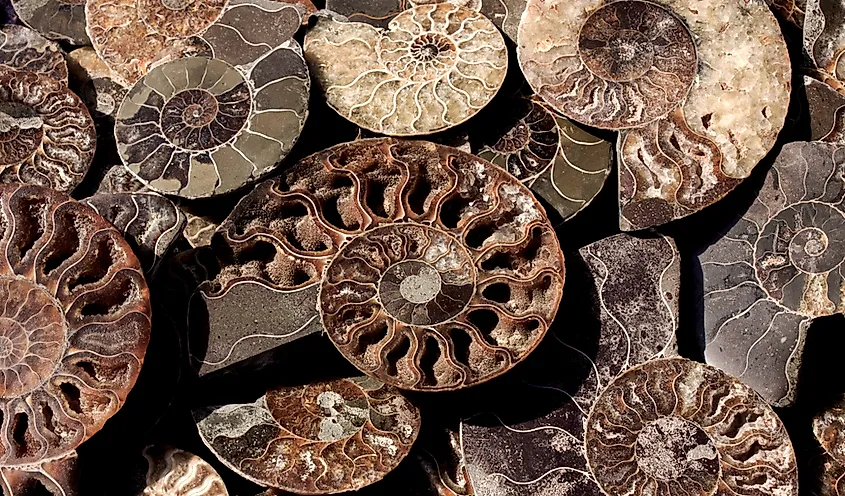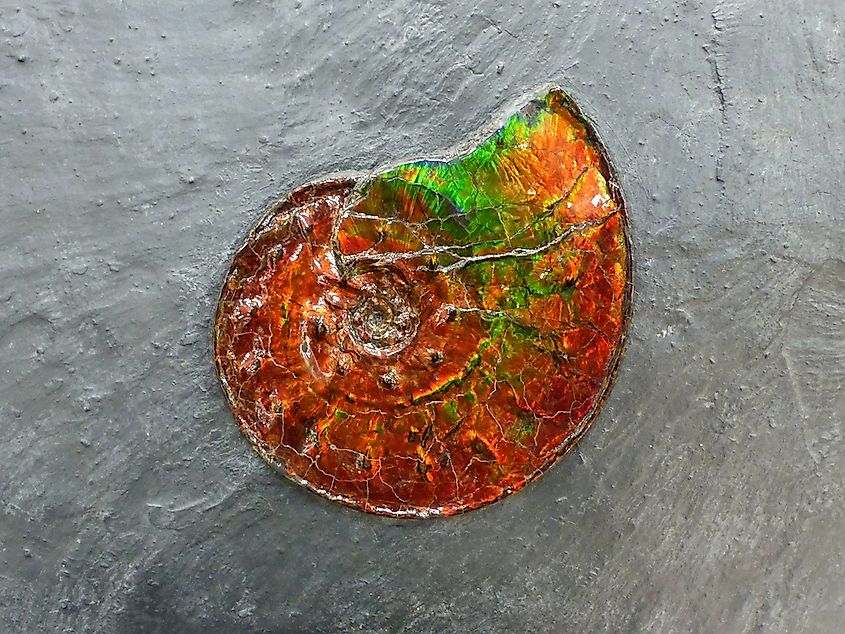Ammolite And Ammonite: What Is The Difference?

Ammonites are fossilized Ammonoids, a group of extinct marine floating and diving mollusks of the class Cephalopods with a spiral shell. They may look similar to nautilus, a modern floating creature, but they are more closely related to coleoids like cuttlefish and octopus. Ammonoids inhabited prehistoric tropical seas between 60 and 240 million years ago until they disappeared during the mass extinction event.
On the other end, ammolite is unique even among "organic gemstones" because it neither has a precise chemical formula nor precisely resembles material produced by living creatures. Ammolite is a gem ammonite, an iridescent layer on its fossilized shell. Well-preserved ammolite also sold Calcenite or Korite, is much rarer than ammonites themselves.
What Is So Special About Ammonites?
Ammonites had some peculiar chapters throughout the history, mainly because of their appearance: to our ancestors, they surely appeared as a stone, often very large, or shining in rainbow colors, yet resembling a living organism features in shape. Historian Pliny called them ammonis cornua (horns of Ammon) after Egyptian god Ammon, portrayed as a ram-horned man.
Because early works of natural history compared the coiled form of the ammonite with that of a curled serpent, ammonites became widely known as snakestones. Because this legend was adding mystic value to these objects, ammonite sellers would often carve snakeheads on them. A Native American local term for ammonites was aapoak - crawling stone. After our frame of reference has expanded, it became clear that it is not a snake but a fossilized shell.

Ammonites are valuable for their historical value, same as other fossils; their size; and, if the outer walls of the shell have been stripped, for their unique pattern. Large ammonites in China are often polished to reveal sutures, the intricate pattern on the surface. Suture patterns are also beneficial for determining a specific species of ammonite.
What Are Ammolites Made Of?
Ammolite is composed primarily of aragonite - the same material that makes for the pearl shine, and the beauty of mother of pearl of abalone and oysters. Ammolite's nacre displays opal-like flashes of color, but often even brighter and more intensely colored.
It is important to note that ammolite is only a very thin sheet of material on the surface of the shell of ammonites - between 0.5 to 0.8 millimeters. And only a tiny fraction of those found was preserved well enough to make for a valuable gemstone. Ammolite is almost always found in a host rock (matrix), mainly chalky clay or limestone. As the seas receded, the ammonites were buried by layers of bentonite sediment. This sediment preserved the aragonite of their shelled remains, preventing it from converting to calcite.
Ammolite As A Gemstone
An iridescent flash of color is possible in all colors of the spectrum, although green and red prevail. Unlike most other gems where the shine comes from the light absorption and reflection, the iridescent color of ammolite comes from light interference inside thin layers stacked over one on another. The thickness of the ammolite determines the dominant colors: thinner layers produce more blues and violets, thicker - reds and greens. Blues and violets are more valuable because thin layers are more fragile and hence rarer.

How Was Ammolite Discovered?
Native American tribes may have used ammolite for decoration and in sacred ceremonies. Still, the gemstone was not revealed to the world until the Geological Survey of Canada discovered it in 1906. It circled among collectors and geologists for decades before a couple of paleontologists searching for fossils discovered some brightly colored ammonite fossils.
When purchasing an ammolite gemstone, you are getting something exceptional, a gem rarer than nearly all others and shaped beneath the ocean for millions of years. The gemstone is the result of tough and expensive work, a full day's toil may produce a bucket's worth of rough stones, and an average of one cup of top quality gemstones emerges each day of the year.
Where Does Ammolite Come From?
All of the notable world's production comes from a small area along the eastern slopes of the Rocky Mountains of the United States and Canada, mainly in Alberta and Montana. Ammonite shells can be found in many other parts of the world, such as the UK or Madagascar, but even when they have some iridescence, the layers are often too fragmented or weak to make for a gemstone.
How did ancient marine creatures end up in the Rockies? Around 70 million years ago, a vast ocean known as the Western Interior Seaway laid to the east of the Rocky Mountains. Millions of ammonites and sediment from the ocean and mountain slopes were "raining" into the bottom. Eventually, the sea receded, and the ammonites, together with the sediment, turned into rock. Later, tectonic activity lifted it into the Rockies.
Unless more locations are uncovered, Ammolite might end up as a "generation gem," same as Tanzanite. It means that the supply of it might be exhausted within one generation. Ammolite was first mentioned in the trade magazine in 1969 and recognized as a gemstone in 1981. Now the largest producer of Ammolite says that deposits of the gemstone will be exhausted within 20 years, and Ammolite jewelry has increased in value by 300% in the past ten years.
How To Recognize A Real Ammolite?
Ammolite is a very valuable and rare gemstone, as well as poorly recognizable due to its relative novelty, so it can be tempting to create imitations using abalone and paua shells or even synthetic materials. It is important to note how the colors change when the ammolite gemstone is moved to detect a real one. But it is still better to buy it from a reputable seller.











